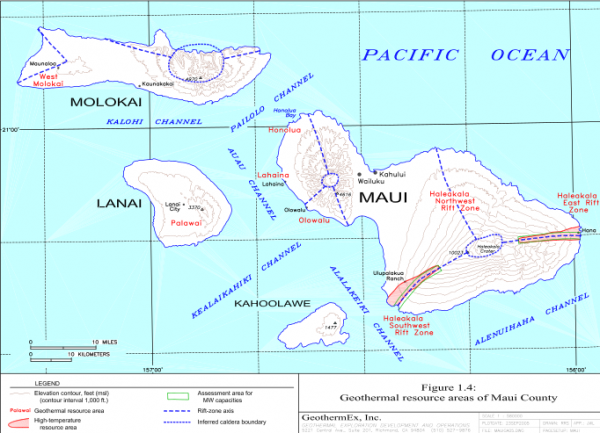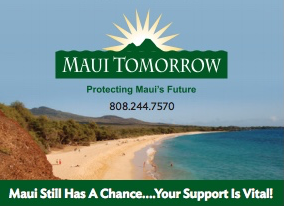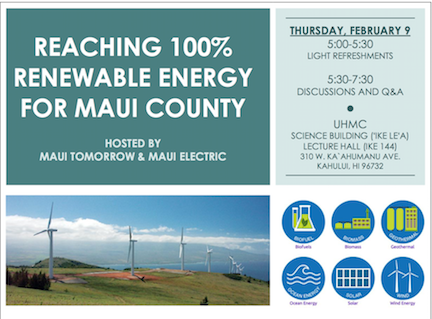Geothermal Generation at Ulupalakua?
by Karen Chun
Maui is blessed with abundant renewable energy resources such as wind and sun. But some of these sources are “nonfirm” or not “dispatchable” meaning that they can fluctuate or quit producing altogether at certain times and the utility cannot increase or decrease electricity generation to match the needs of electricity consumers, which change throughout the day.
Firm vs nonFirm:
Because our utility operating policies were developed during a time of abundant oil, we expect our utility to supply all the electricity we need 24/7. Therefore a utility with substantial wind and solar generators must still maintain dispatchable generating capacity equal to the peak demand. Barring a policy change, there are two solutions: build storage to “firm up” the nonfirm power or look for non-oil sources of dispatchable power.
Storage Options:
Kaheawa Wind Farm is planning to install huge backup batteries. However these are only meant to supply power during the few minutes it takes for MECO to bring their diesel generators online. On the mainland, pumped hydro is used to store energy and firm up wind or solar. During times of excess generation, water is pumped to a high reservoir. During times of low generation, the water falls down to the lower reservoir through the turbines and generates back most of the energy that was stored. So far Maui has not availed itself of this old and reliable technology.
Firm Alternative Energy Power
Ormat Technologies (www.ormat.com) has obtained U.S. Department of Energy funding to explore the Ulupalakua Ranch area above La Perouse Bay to see if a commercial geothermal resource exists in the area. Geothermal is a firm source of power and can replace some diesel generation.
Ormat operates the 30MW Puna Geothermal Venture geothermal plant on the Big Island. If Ormat were to discover a commercial resource beneath the Ulupalakua Ranch, they may seek approval to construct a commercial binary plant on Maui.
Heated water from deep underground (geothermal wells are typically 5,000 to 10,000 feet below the ground’s surface) flashes into steam to drive a turbine. Then, in a second stage, the hot water condenses after passing through the turbine and heats a working fluid which has a boiling point lower than water. This second fluid drives a second turbine. The cooled geothermal water is then returned to the underground reservoir where it is reheated and reused. All fluids (the geothermal water and working fluid) are enclosed and not released into the environment.
Geothermal resources are owned by the State of Hawaii, so unlike all other forms of energy used in Hawaii, geothermal companies pay a share of the money received from selling electricity, directly to the State of Hawaii (called “royalties”). Between 2001 and 2009, Puna Geothermal Venture paid over $12 million to the State Department of Land and Natural Resource, the County of Hawaii, and the Office of Hawaiian Affairs. Ormat would be paying additional royalties to the State if they are successful in developing commercial generation at Ulupalakua Ranch.
In 1983, the Legislature authorized the Board of Land and Natural Resources to designate “geothermal resources subzones”. Only those areas designated as “geothermal resource subzones” may be utilized for the exploration, development or production of electrical energy. (HRS Chap 205) . The Maui County Energy Alliance estimates that Maui might have 140MW of geothermal generating potential. The map below shows the identified Hawaii Geothermal Subzones.
Ormat plans on asking the state to increase the designated subzone on Ulupalakua land slightly. The bad news is that industry-wide about 80% of geothermal test wells turn out to be inadequate for commercialization. A well needs both heat (which is likely to exist given the volcanic environment on Maui) but also needs water. Ormat hopes to soon begin studying environmental conditions at Ulupalakua Ranch to see what areas may be suitable for geothermal development. If Ormat receives the necessary approvals, the Department of Energy grant would partially fund two test wells, with Ormat paying the remainder of the cost.
If lands classified as “Agricultural Land Use” by the State are to be utilized, then other laws come into play, such as Maui’s Upcountry Community Plan which states, “While the potential benefits of geothermal development would accrue to the entire island, the environmental impacts would be primarily borne by the communities of Ulupalakua and Kanaio. For this reason, and in respect to Native Hawaiian sensitivities, a policy prohibiting geothermal development that impacts adversely on Upcountry communities or culturally sensitive resources has been adopted.” And also “Prohibit geothermal energy development that would negatively impact the Upcountry region or diminish culturally sensitive resources.”
Ormat also plans on asking the State to issue a lease of the geothermal resources at Ulupalakua Ranch. Ormat will do a single EIS for their subzone expansion application and their lease application. The EIS will examine what areas around the Ranch, if any, are suitable for possible future geothermal development. If the State approves these application, Ormat would do an environmental analysis focused on the locations of any test wells it might drill.
If Ormat’s exploration is successful, only then would it consider applying for permission to construct a power plant at Ulupalakua. They say that, at this time, they are only doing a feasibility study and seeking to test drill and that the decision to build a commercial plant won’t be made until they have all their data.
What are the possible negatives if they do construct a commercial geothermal plant?
Hydrogen Sulfide: In older mainland plants, there have been cases where Hydrogen Sulfide was released during generation. H2S is a poisonous, rotten-egg smelling gas. Ormat’s generating system is closed and designed not to release H2S into the atmosphere. However, H2S could be released during drilling and Ormat has detection and alarm equipment planned.
Water Quality: We all know that water is a big issue in the Ulupalakua region. Ormat says that the geothermally-heated water they would be using comes from far below sea level (5,000 to 10,000 feet below ground) and that they return the water just upstream of where they take it. They use tracers to determine the path the underground water takes. When needed, geothermal wells are sealed-off to prevent the geothermal water from interacting with any ground water that the well may encounter. If geothermal fluid is used, there will be no effect on ground water other than a negligible cooling of the geothermal resource.
Cultural Resources: Once Ormat completes its cultural resource survey at Ulupalakua Ranch, we’ll have a better idea of cultural resources in the area. Because geothermal development has a small footprint, Ormat says they often works in areas where cultural resources are present without disturbing those resources.
Noise: The Puna plant is noisier than newer geothermal power plants. Ormat (who operates but did not build the Puna plant) plans on using a closed loop technology that is quieter. Ormat says they recently collected noise data showing noise from its newer power plants is at background level within 1/4th mile. Drilling is noisier, but is also usually down to background level at 1/4th mile. The area in which they’ll operate is doesn’t have much “background level” noise and has few features to block sound. In the author’s opinion this noise carrying estimate might need to be revised somewhat for Ulapalakua conditions.
Transmission Lines: If Ormat were to discover a commercial resource and construct a power plant at Ulupalakua Ranch, transmission lines may need to be built and this could pose visual blight and construction impacts.
Advantages:
Emissions from closed geothermal plants are virtually nil – no CO2 , no H2S and negligible particulates. Geothermal is an extremely effective way of generating electricity without adding CO2 to the atmosphere.
This is firm renewable power and displaces the diesel generators that Maui Electric has been using with low cost alternative generation.
Geothermal power can be dispatchable, which could make it easier to develop other, nonfirm renewable power sources such as wind and solar on Maui.
Geothermal is one of the cheapest power sources.
Geothermal has one of the smallest footprints of any energy source. A geothermal power plant requires only about 5 acres and geothermal wells sites are only 2-4 acres.
Because geothermal development does not require tall structures, visual impact is minimal (other than transmission lines).
Royalty payments from geothermal power provide direct benefits to the community.
The Future
Ormat says they currently have no plans to construct a power plant at Ulupalakua Ranch, but if the resource proves commercially feasible, Ormat typically starts with a 30MW plant.
There still remain some hurdles for Ormat – getting designation as a geothermal subzone on part of their Ulupalakua lease that wasn’t included in the State’s designation, getting a permit from Maui County who must create the permit process, getting a state lease on the parcels that are outside of Ulupalakua Ranch’s control, completing the EIS process and most of all – successful test wells.
If all goes as planned this looks like an important step towards Maui’s energy independence.





Comment(1)-
Karen Chun says
March 25, 2011 at 6:50 pmThere have been rumors going around about “fracking” on Maui. As far as I can tell these have no basis in fact.
Hydraulic fracturing is a process that results in the creation of fractures in rocks in order to release more oil or gas.
The fracture fluid can be water, gels, foams, nitrogen, carbon dioxide or even air. Sometimes sand, resin-coated sand, or man-made ceramics are added to the fluid.
The problem with fracking for natural gas or oil is that either a toxic substance is added to the fracking water or the toxic fossil fuels that are the target of fracking seep into the ground water and pollute drinking supplies. Hence the videos you may have seen where people light the water from their kitchen faucet on fire because the natural gas has escaped into the water supply.
The oil and gas industry uses toxic chemicals in the fracking fluid which have been implicated in cancer and endocrine disruption.
There is no geologic reason to think that any fossil fuel deposits will be found in any Hawaiian island. (The Hawaiian Islands are too young.) Ormat’s representative was adamantly opposed to fracking during a general discussion of the advantages of geothermal vs oil and gas.
So to repeat: The contamination associated with “fracking” comes from toxic additives to the fluid and/or from the oil/gas deposits themselves. Neither appear to be involved in geothermal power plants on Maui.
The misunderstanding may have arisen because Ormat will be returning the water it extracts from deep below the surface back into the same area underground. This is the responsible and customary method of managing geothermal resources.